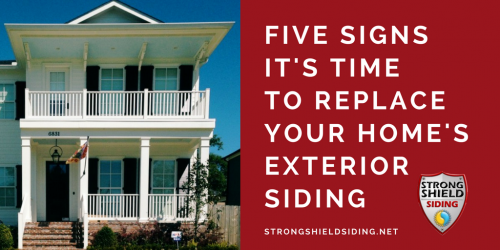Blog
Is it time to re-side your home?

Re-siding your home can be intimidating, but sometimes it’s necessary to refresh its curb appeal and protect its interior. Because it’s not a small undertaking, we’ve created this three-part blog series to help you determine if it’s time for you to re-side your home and what you can expect when you take Strong Shield Siding along for the ride.
Is it time to re-side my home?
Five signs your siding needs to be replaced:
1. Your home needs frequent painting.
If your home needs exterior painting every 4-5 years, this is an indication of poor siding conditions. Quality siding should keep its shape and color for a minimum of 8-10 years. By updating your siding, you’ll save money and the headache of frequent updates.
2. Your current siding is cracked, faded or loose.
If large sections of your current siding show signs of cracking, or if multiple pieces are loose, this indicates severe problems that need professional attention. Cracked, broken and loose pieces of siding must be removed and replaced, or your home’s interior is vulnerable to water damage.
3. The interior walls of your home have obvious signs of water damage.
The quality of siding in your home has an impact on the conditions within your home. High-quality siding will protect the interior of your home from water which may make its way through your current siding. This damage can manifest as paint or wallpaper peeling, mold or mildew, or water stains.
4. Wooden elements in your home are rotting, buckling or warping.
Beyond superficial signs, poor siding conditions can cause further headache due to moisture. Rotting, buckling and warping are clear indicators that moisture is getting into your home. If left alone this damage will only get worse, leading to a serious decrease in the value of your home.
5. There are signs of dry rot.
Weak siding in any section of your home’s exterior leaves you exposed to serious problems. This weakness could lead to dry rot, a type of fungus that eats the wooden frame of your home. Eventually the wood becomes weak, cracks, and disintegrates. As you can imagine, this causes further interior problems.
Check back next week for part two in our series about re-siding your home!




